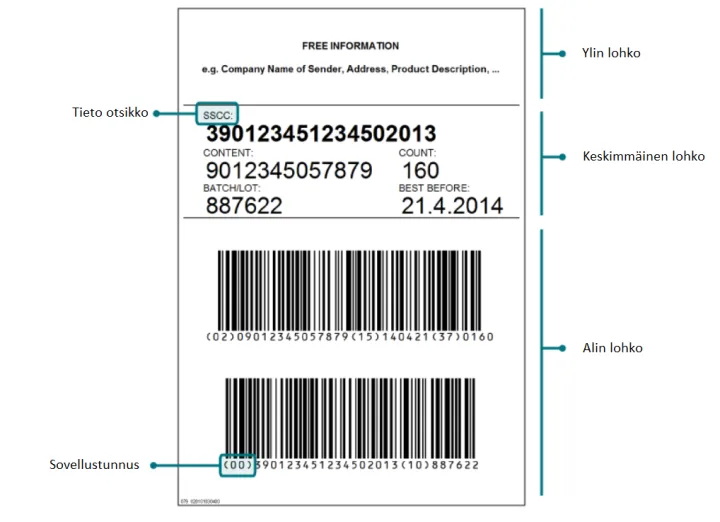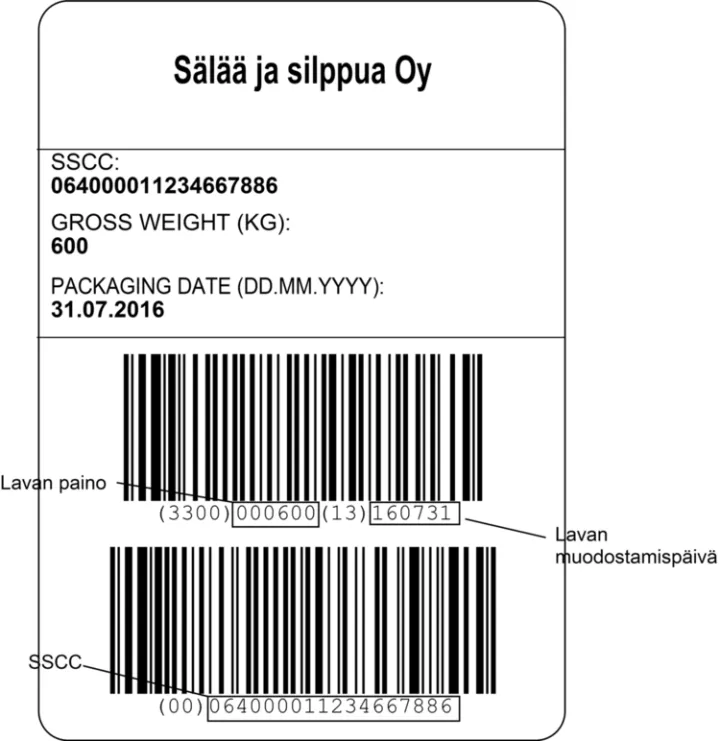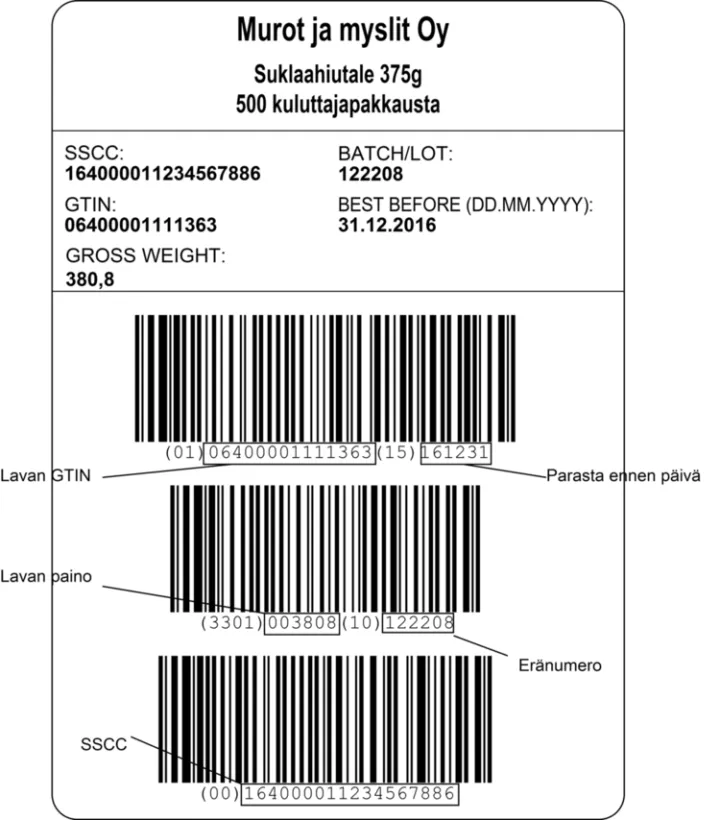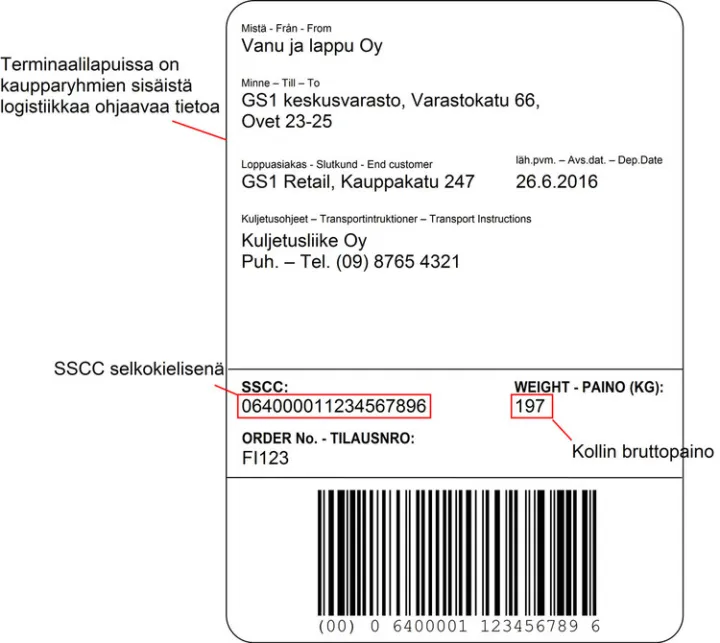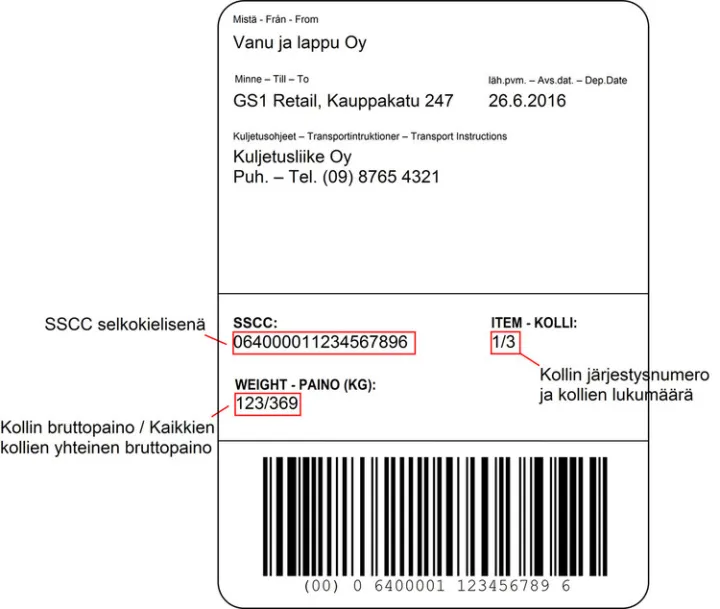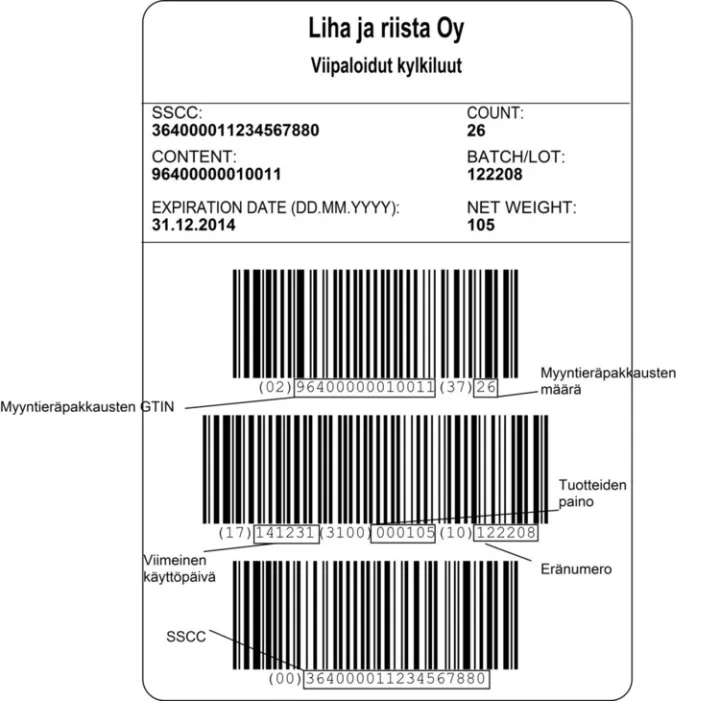
How to mark a delivery
Logistic unit identifier SSCC
When a pallet or other logistic unit is sent to the recipient and you want to follow its progress in the supply chain, the GS1 logistic unit identifier, SSCC, is used. While GTIN is a product identifier that identifies, for example, a retail product or its sales batch, SSCC identifies each logistical unit that is sent, such as a pallet, roll box or package. A logistic unit is any packaging unit used for both transport and storage that is handled in the supply chain.
With SSCC, companies can track each logistic unit they send efficiently through the entire supply chain. For example, if the shipment contains five identical logistic units, each unit is marked with its own SSCC code, which distinguishes it from other units.
GS1-128 barcode
Often, the purpose of use determines which barcode type should be used. The GS1-128 barcode is used to mark logistic units. In addition to the GTIN code of the product contained in the package, additional information such as batch number and/or date information can be coded using GS1 application codes. The GS1-128 barcode is not intended to be read by a POS terminal.
Read more about the GS1-128 barcode >
Pallet label
Pallets contain several sales batch packages or consumer packages and are marked with a GS1 standard pallet label. The pallet label allows the pallet to be traced throughout the supply chain.
Pallet label consists of three blocks:
- The top block contains free information, for example the sender's contact information. This is a so-called optional section, where the company creating the pallet label can itself choose the information content. It is common for the company name and/or logo and information about the product to be printed on the top block. The top block can also be left blank if there is no need for free information.
- The middle block contains the information found in barcodes in plain text format. It is possible that for some reason the barcodes are not readable at the time of reading, why should the information in the barcodes be printed on the stage label also in plain language. The middle block therefore contains textual information about the contents of the logistic unit, for example the identifier, weight and expiration date of the included product.
- The bottom block contains barcodes. The barcodes on the pallet label are made with GS1-128 barcode technology.
On the pallet label, the SSCC code is the minimum information and as additional information for traceability, the product identifier and quantity as well as the batch and date information are recommended in barcode format.
Choosing the right kind of pallet label
How do you deliver your products to the customer? The delivery model affects the choice of GS1 label to use. For terminal deliveries, the marking is usually different from for central warehouse deliveries. In addition, the pallet label for variable-measure products differs from the traditional pallet label. Below you will find examples of different stage boards.
Delivery to the central warehouse
The supplier delivers his products to the customer's central warehouse. The supplier is instructed to form the pallets so that there is one product on the pallet with the same date and batch number. It is also possible to deliver variable-measure products and, in some cases, mixed pallets to the central warehouse.
Terminal delivery
The supplier delivers his product to the customer's terminal. Often the supplier is asked to mark the delivery with the end customer's information.
Direct delivery to the store
The supplier delivers his products directly to an individual store. Products do not go through the central warehouse or terminal.
Marking of a pallet containing products of variable dimensions
A pallet containing variable size products can be numbered with either GTIN-13 or GTIN-14 number. The product number is used so that the recipient's background system recognizes the pallet and the data is normally transmitted to the recipient electronically.
When pallet is not a product
If the pallet is not a product to be ordered, it can be identified by either GTIN-13 or GTIN-14 code. The GTIN is usually transferred to the buyer along with the product information and should not be included in the barcode on the stage tag. Instead, the pallet label includes the GTIN of the sales batch package, the weight of the pallet, the number of sales batch packages contained in the pallet and the SSCC of the pallet. The pallet label can also be used to indicate other information, such as the expiry date and the batch number.
When pallet is a product
If the pallet is a product to be ordered, it must be given GTIN-14. The GTIN number begins with the number 9, in the same way as when identifying variable-measure batch packages. On the pallet label, the barcode should contain, in addition to the GTIN code of the pallet, also information on the total weight of the pallet and the SSCC of the pallet, but may also include, for example, the expiry date and the batch number.
Parcel
The packages formed for delivery, which are smaller than the pallet, i.e. parcels, are marked with parcel address labels. It includes the customer, address and route information that guides the delivery. If there are several parcels in the same shipment, their total number must also be noted on the label. The SSCC code is used as the identifier of the individual parcel.
The parcel address label is created in the same way as for direct delivery to the store (see the section Choosing the right kind of pallet label – Direct delivery to the store).

